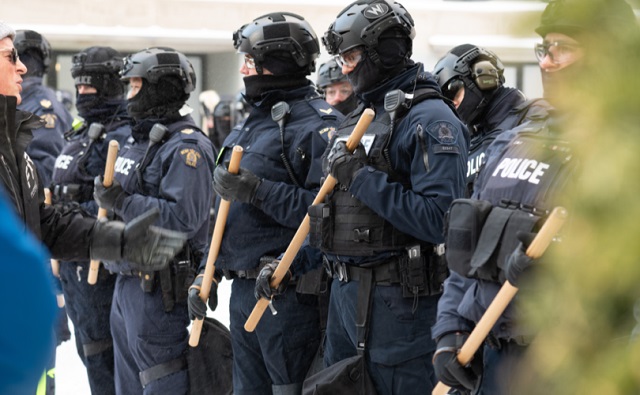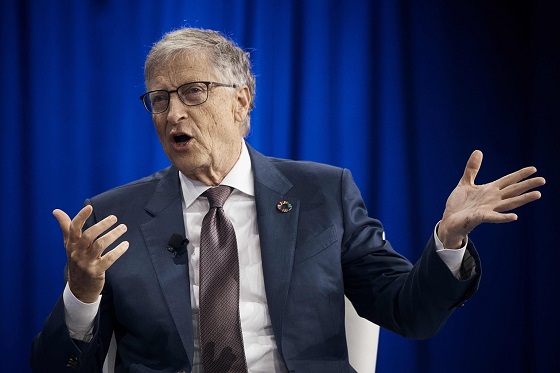COVID-19
Freedom Convoy judge questions why Ottawa police officers had phone data wiped during protest

From LifeSiteNews
Justice Heather Perkins-McVey noted that it was ‘unusual’ that the officers knew ‘they had to have their phones upgraded and yet did not take the responsible steps to ensure that all the evidence and disclosure was preserved.’
The trial for Freedom Convoy leaders Tamara Lich and Chris Barber resumed Thursday this week, seeing Justice Heather Perkins-McVey note that it was “unusual” that two Ottawa Police Service (OPS) officers who interacted with protestors had their phone data wiped during the protests.
Perkins-McVey said in court that the OPS officers “knew they had to have their phones upgraded and yet did not take the responsible steps to ensure that all the evidence and disclosure was preserved.”
The Democracy Fund (TDF), which is crowdfunding Lich’s legal costs, noted in a Day 22 trial update that Perkins-McVey found it “interesting that two PLT [Police Liaison Team] officers had their phones wiped” of important Signal chats between them and protestors.
“She questioned how many other officers had experienced the same,” noted the TDF.
Last Thursday, during Day 20 of the trial, a second police witness, Nicole Bach of the OPS PLT, testified her police-provided phone was “wiped” of all information when asked by the judge if she had copies of vital information of conversations between her and protesters.
Bach was the second police officer in less than a week to testify that their phone was suddenly “wiped” of all data.
OPS liaison team officer Isabelle Cyr testified last week that her contacts were “wiped” clean from her phone between January 27 and February 9, 2022, which was when the main protests took place.
She noted to the court, however, that she had some text message exchanges with Freedom Convoy organizer Chris Barber printed out before her information was “wiped.”
Yesterday in court, defense counsel Eric Granger referred to an email from an Officer “Li” which was made to Bach, and suggested that by May 2022, it was evident that the “PLT officers were seeking evidence that might have been lost while highlighting the absence of an email response from Bach in the disclosure.”
“He argued that this evidence could also affect the credibility of the officers involved,” noted the TDF.
Diane Magas, counsel for Chris Barber, “reiterated her request for a response regarding when Bach was directed to update her phone and why she updated it when she did, leading to the phone’s wipe.”
Last Friday, during Day 21 of the trial, Bach was again cross-examined which resulted in disclosure concerns pertaining to her testimony on Day 20 about her phone getting wiped.
As per the TDF, the “defense team requested disclosure about the reasons behind the ‘wiping’ of Officer Bach’s cell phone. The Crown and defense left the courtroom together to discuss the issue.”
Documents requested by the defense given to them in ‘blacked out’ form
Lich and Barber’s defense has thus far only received completely blacked-out documents concerning the phone wipes of the OPS officers.
On Thursday in court, lawyers for Lich and Barber noted to the court they got copies of five internal emails they had requested, which were said to be communications between officers, but they were heavily redacted and wondered why this was the case.
The OPS had claimed the emails were protected by solicitor-client privilege.
Lawyer Vanessa Stewart, who was in court on behalf of the OPS, claimed that some of the emails have evidence from the Crown, which was shared between officers.
The TDF noted that “Granger pointed out that solicitor-client privilege typically does not exist between the police and the crown, leading to discussions about the involvement of the crown in such legal discussions with the police.”
Perkins-McVey inquired to Crown lawyers if the “Ottawa police were in a position to waive privilege, assuming privilege existed in the first place.”
Stewart replied with a “No.”
The TDF noted that Perkins-McVey questioned how communication “between two officers could trigger solicitor-client privilege.”
In response, Stewart “maintained that the conversation was about legal advice received from the crown, justifying the privilege.”
Perkins-McVey “noted that it was not clear whether solicitor-client privilege had been sufficiently established.” Stewart after this, “then made submissions on the waiver of privilege.”
Lich and Barber’s trial has thus far taken more time than originally planned due to the slow pace of the Crown calling its witnesses. LifeSiteNews has been covering the trial extensively.
Last week, bail-related charges placed against Lich for attending an awards ceremony were stayed by the Crown in a move that comes during her weeks-long trial for leading the convoy, which is separate from her bond charges.
In early 2022, the Freedom Convoy saw thousands of Canadians from coast to coast come to Ottawa to demand an end to COVID mandates in all forms. Despite the peaceful nature of the protest, Prime Minister Justin Trudeau’s federal government enacted the Emergencies Act in mid-February, leading to Lich’s arrest two days later on February 17, 2022.
After the protesters were cleared out, which was done through the freezing of bank accounts of those involved without a court order as well as the physical removal and arrest of demonstrators, Trudeau revoked the EA on February 23.
COVID-19
Trump DOJ seeks to quash Pfizer whistleblower’s lawsuit over COVID shots

From LifeSiteNews
The Justice Department attorney did not mention the Trump FDA’s recent admission linking the COVID shots to at least 10 child deaths so far.
The Trump Department of Justice (DOJ) is attempting to dismiss a whistleblower case against Pfizer over its COVID-19 shots, even as the Trump Food & Drug Administration (FDA) is beginning to admit their culpability in children’ s deaths.
As previously covered by LifeSiteNews, in 2021 the BMJ published a report on insider information from a former regional director of the medical research company Ventavia, which Pfizer hired in 2020 to conduct research for the company’s mRNA-based COVID-19 shot.
The regional director, Brook Jackson, sent BMJ “dozens of internal company documents, photos, audio recordings, and emails,” which “revealed a host of poor clinical trial research practices occurring at Ventavia that could impact data integrity and patient safety […] We also discovered that, despite receiving a direct complaint about these problems over a year ago, the FDA did not inspect Ventavia’s trial sites.”
According to the report, Ventavia “falsified data, unblinded patients, employed inadequately trained vaccinators, and was slow to follow up on adverse events reported in Pfizer’s pivotal phase III trial.” Overwhelmed by numerous problems with the trial data, Jackson filed an official complaint with the FDA.
Jackson was fired the same day, and Ventavia later claimed that Jackson did not work on the Pfizer COVID-19 shot trial; but Jackson produced documents proving she had been invited to the Pfizer trial team and given access codes to software relating to the trial. Jackson filed a lawsuit against Pfizer for violating the federal False Claims Act and other regulations in January 2021, which was sealed until February 2022. That case has been ongoing ever since.
Last August, U.S. District Judge Michael Truncale dismissed most of Jackson’s claims with prejudice, meaning they could not be refiled. Jackson challenged the decision, but the Trump DOJ has argued in court to uphold it, Just the News reports, with DOJ attorney Nicole Smith arguing that the case concerns preserving the government’s unfettered power to dismiss whistleblower cases.
The rationale echoes a recurring trend in DOJ strategy that Politico described in May as “preserving executive power and preventing courts from second-guessing agency decisions,” even in cases that involve “backing policies favored by Democrats.”
Jackson’s attorney Warner Mendenhall responded that the administration “really sort of made our case for us” in effectively admitting that DOJ is taking the Fair Claims Act’s “good cause” standard for state intervention to mean “mere desire to dismiss,” which infringes on his client’s “First Amendment right to access the courts, to vindicate what she learned.”
Mendenhall added that in a refiled case, Jackson “may be able to bring a very different case along the same lines, but with the additional information” to prove fraud, whereas rejection would send the message that “if fraud involves government complicity, don’t bother reporting it.”
That additional information would presumably include the FDA’s recent admission that at least 10 children the agency has reviewed so far “died after and because of receiving COVID-19 vaccination.”
“The truth is we do not know if we saved lives on balance,” admitted FDA Chief Medical Officer Vinay Prasad in a recent leaked email. “It is horrifying to consider that the U.S. vaccine regulation, including our actions, may have harmed more children than we saved. This requires humility and introspection.”
The COVID shots have been highly controversial ever since the first Trump administration’s Operation Warp Speed initiative prepared and released them in a fraction of the time any previous vaccine had ever been developed and tested. As LifeSiteNews has extensively covered, a large body of evidence has steadily accumulated over the past five years indicating that the COVID jabs failed to prevent transmission and, more importantly, carried severe risks of their own.
Ever since, many have intently watched and hotly debated what President Donald Trump would do about the situation upon his return to office. Though he never backed mandates like former President Joe Biden did, for years Trump refused to disavow the shots to the chagrin of his base, seeing Operation Warp Speed as one of his crowning achievements. At the same time, during his latest run he embraced the “Make America Healthy Again” movement and its suspicion of the medical establishment more broadly.
So far, Trump’s second administration has rolled back several recommendations for the shots but not yet pulled them from the market, despite hiring several vocal critics of the COVID establishment and putting the Department of Health & Human Services under the leadership of America’s most prominent anti-vaccine advocate, Robert F. Kennedy Jr. Most recently, the administration has settled on leaving the current jabs optional but not supporting work to develop successors.
In a July interview, FDA Commissioner Marty Makary asked for patience from those unsatisfied by the administration’s handling of the shots, insisting more time was needed for comprehensive trials to get more definitive data.
COVID-19
Canadian Health Department funds study to determine effects of COVID lockdowns on children

From LifeSiteNews
The commissioned study will assess the impact on kids’ mental well-being of COVID lockdowns and ‘remote’ school classes that banned outdoor play and in-person learning.
Canada’s Department of Health has commissioned research to study the impact of outdoor play on kids’ mental well-being in light of COVID lockdowns and “remote” school classes that, for a time, banned outdoor play and in-person learning throughout most of the nation.
In a notice to consultants titled “Systematic Literature Reviews And Meta Analyses Supporting Two Projects On Children’s Health And Covid-19,” the Department of Health admitted that “Exposure to green space has been consistently associated with protective effects on children’s physical and mental health.”
A final report, which is due in 2026, will provide “Health Canada with a comprehensive assessment of current evidence, identify key knowledge gaps and inform surveillance and policy planning for future pandemics and other public health emergencies.”
Bruce Squires, president of McMaster Children’s Hospital of Hamilton, Ontario, noted in 2022 that “Canada’s children and youth have borne the brunt” of COVID lockdowns.
From about March 2020 to mid-2022, most of Canada was under various COVID-19 mandates and lockdowns, including mask mandates, at the local, provincial, and federal levels. Schools were shut down, parks were closed, and most kids’ sports were cancelled.
Mandatory facemask polices were common in Canada and all over the world for years during the COVID crisis despite over 170 studies showing they were not effective in stopping the spread of COVID and were, in fact, harmful, especially to children.
In October 2021, then-Prime Minister Justin Trudeau announced unprecedented COVID-19 jab mandates for all federal workers and those in the transportation sector, saying the un-jabbed would no longer be able to travel by air, boat, or train, both domestically and internationally.
As reported by LifeSiteNews, a new report released by the Justice Centre for Constitutional Freedoms (JCCF) raised alarm bells over the “harms caused” by COVID-19 lockdowns and injections imposed by various levels of government as well as a rise in unexplained deaths and bloated COVID-19 death statistics.
Indeed, a recent study showed that COVID masking policies left children less able to differentiate people’s emotions behind facial expressions.
COVID vaccine mandates and lockdowns, which came from provincial governments with the support of the federal government, split Canadian society.
-

 National2 days ago
National2 days agoCanada’s free speech record is cracking under pressure
-

 Energy2 days ago
Energy2 days agoTanker ban politics leading to a reckoning for B.C.
-

 Energy2 days ago
Energy2 days agoMeet REEF — the massive new export engine Canadians have never heard of
-

 Energy13 hours ago
Energy13 hours agoCanada’s future prosperity runs through the northwest coast
-

 Fraser Institute2 days ago
Fraser Institute2 days agoClaims about ‘unmarked graves’ don’t withstand scrutiny
-

 Business2 days ago
Business2 days agoToo nice to fight, Canada’s vulnerability in the age of authoritarian coercion
-

 Alberta2 days ago
Alberta2 days agoHere’s why city hall should save ‘blanket rezoning’ in Calgary
-

 Business1 day ago
Business1 day agoThe world is no longer buying a transition to “something else” without defining what that is



